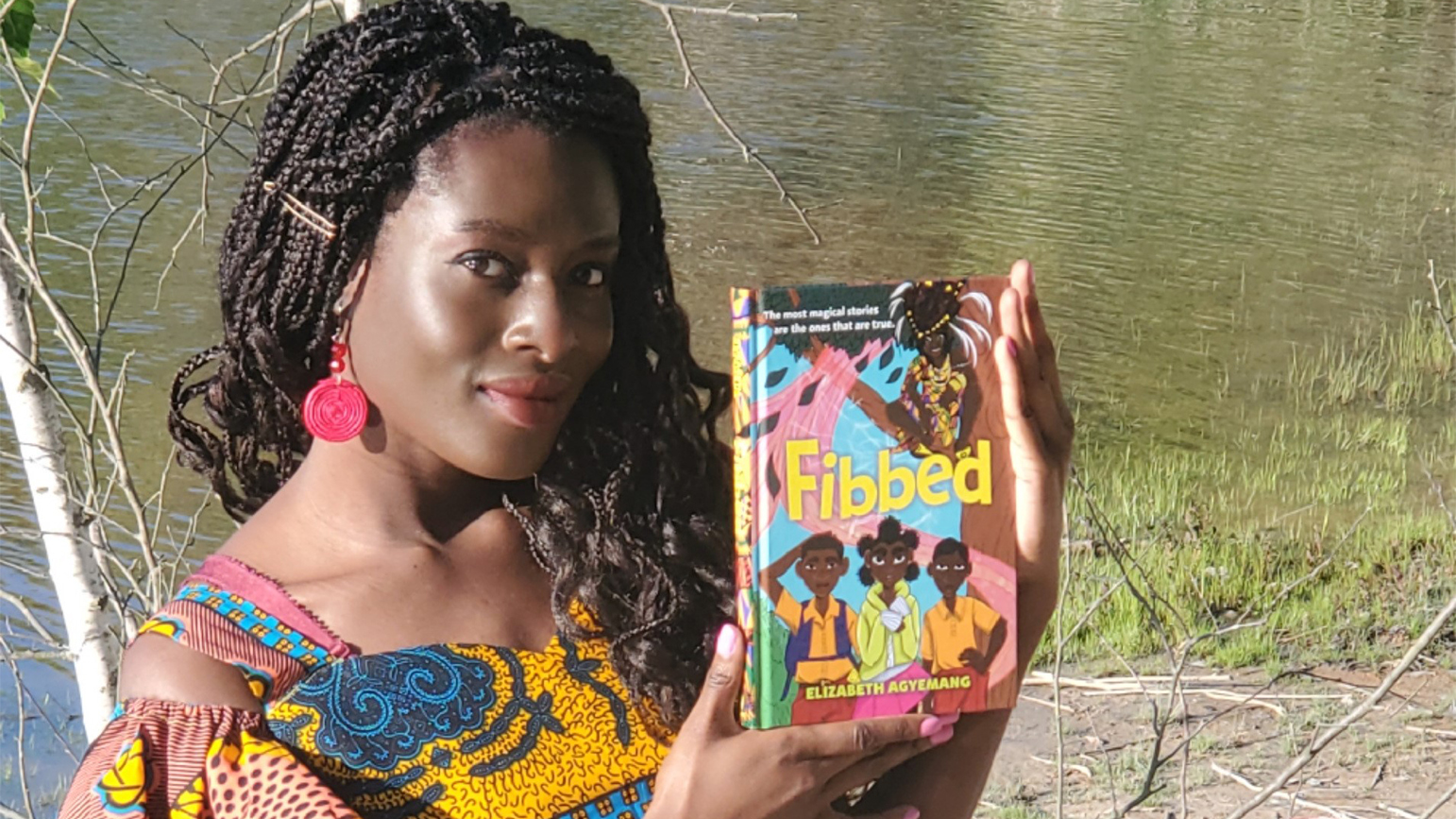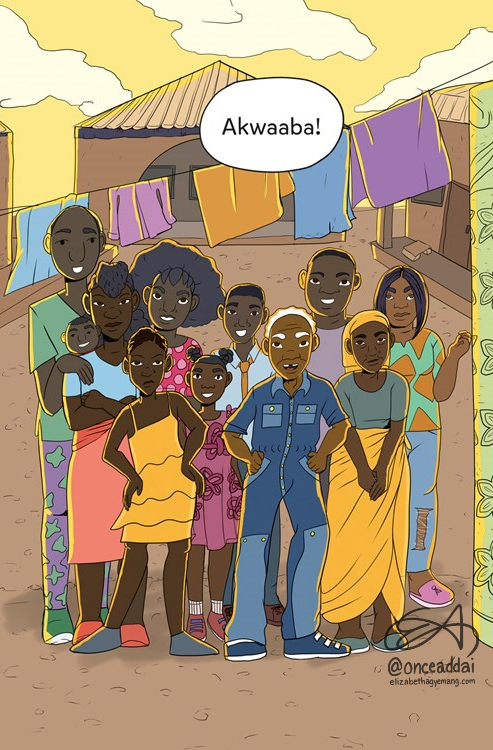
“5 Questions” is an ongoing series with School of Art alumni who are transforming art, culture, and technology, exploring their creative practices, career milestones, and Carnegie Mellon memories.
Elizabeth Agyemang is an illustrator, printmaker, and storyteller. She writes about magic, history, folklore, love, and fairy tales, and draws from elements of her Ghanaian heritage and faith. Her first book, Fibbed, was published this past summer.
Elizabeth graduated from Carnegie Mellon University where she studied Fine Arts and Professional Writing, and she now works in publishing. She was recently named a finalist in Publisher Weekly’s Star Watch, which celebrates the rising stars of the publishing industry.
1
What inspired you to write Fibbed?
Like many creators, I think sometimes an idea comes to you when you least expect it. For me, the story of Fibbed took root when I returned to Ghana for the first since my family and I immigrated to the USA. There, I was able to reconnect with family and experience a bonfire recounting by elders of the Ananse folktales that would inspire the book. While I took this trip in high school, in Fibbed, my main character Nana is in middle school when she spends her summer with her grandparents abroad and it’s there that she meets one of the central figures from African folktales, the mythical spider “Ananse”.
The themes that spoke to me while creating this story center on community, culture, and environmental stewardship. I also wanted to talk about something that had always puzzled me as a child which is the idea that one can tell the truth and not be believed. To me, that was unfathomable. The truth is the truth, is the truth, right? But I quickly learned that, in the world we live in, injustices have carved a wedge between simply telling the truth and being believed, and the intersections of one’s identity and background have historically been a determining factor for the later. While that has often been disheartening to see, the truth doesn’t change just because others don’t believe it, and being reminded of that has been a place of hope and optimism for me. Through this book, I explore these subjects as Nana uses the folktales of her community, and investigative journalism to try and save the forest in her family’s village from a group of greedy contractors attempting to exploit its resources. Ultimately, Fibbed is about searching for the truth, and finding instead, the power that comes in believing; in others, in ourselves, and in the intangible.

2
What is your process for writing and illustrating? Could you give us an idea of how your work comes alive, from idea to published book?
The process for writing and illustrating the book began actually, again, before I realized it. I’d always made comics growing up, but I sort of put the art form aside in high school. It wasn’t until I discovered printmaking as a student in CMU’s School of Art that I found another creative avenue to return to sequential mediums. Printmaking in itself is kind of sequential, it’s about process, layering and adding to this visual language. My primary practice at CMU was printmaking, and through printmaking I started working on zines and screen printing books that dealt with sequential narratives. To screen print, you have to “trust in the process” and that’s sort of how I’ve come to learn making a graphic novel is like. For me, that means sketching out some characters, writing a script for them and then, layer by layer, building that story through sketches, and inks, and flats and final colors.
To bring Fibbed to life I started with a concept: a girl who always tells the truth but never is believed. Then, I dug in to figure out who this girl was and pulled from my own background: a summer trip to Africa. From there, I created a proposal outlining the story and showing a look into the concept through sample pages. I then pitched the book to my now literary agent, who then pitched the story to editors at publishing houses. My current editor loved the concept but wanted to iron out pieces and share her vision for the story. Publishing a book in itself is very collaborative, and outside of working with my publishing house Penguin Random House, one of the most pivotal pieces was connecting with my family members, speaking to my parents, my cousins and elders in my community about the Ananse stories and folktales I was taking inspiration from. While I wrote the story and illustrated every page in the book, it was ultimately through this collaboration of bouncing ideas and through iteration that the book came to life.
3
Tell us about your work at the publishing imprint Clarion. You recently said that your mission “to open a door for the story that I didn’t get to see growing up.” Could you explain what that looks like in practice?
So, I always feel like my path in telling stories and bringing stories to readers converged at some point. I was a big reader growing up, and one of my favorite things was not just telling stories of my own, but bring stories to others. Whether that be through a book recommendation or forcing a new work of fiction into my sibling’s hands, I was always in awe of perspectives different than my own. But as many perspectives as I expected to find in bookshelves at stores or in the library, I always felt like there were so many different stories from people of color that I didn’t get to see growing up. What would a fantasy world look like from the lens of a Black girl in a steampunk world or for two twins on a series of magical quests in a kingdom inspired by Filipino culture? I think my calling, more than mission, is to work with creators from diverse backgrounds to bring their stories to readers. As an editor, I’m able to open a door for those creators and their stories—just as that door was opened to me. In practice, that means acquiring those stories, working with their creators, and championing them and their works. I’ve been in the publishing industry since graduating from CMU, so about five years now, I’ve been able work with creators to bring their stories to readers. As my role focuses particularly on children’s books, my hope is that the young reader of tomorrow is able to see a reflection of themselves and the perspective of someone different from them through the pages of literature.

4
Could you talk a bit about your time as an undergraduate at CMU’s School of Art? Are there any experiences you had as a student that stand out?
I loved my experience at CMU’s School of Art. I was able to learn from incredible professors from so many different creative fields and I got to grow with my classmates and come into my own as a person and a creative. When I started as a freshman at CMU, my older sister was actually a senior in CFA as well, and my favorite memories were getting to see her work and showing her my own pieces in my debut Frame Gallery show. I also loved working in studio, discovering the wonders of woodworking, welding, coding, and printmaking, and growing with my classmates. Junior and senior year, my friends and I established Carnegie Mellon’s first ever (as far as we know) print club: the silkworms. That was an amazing period, and the professors of the School of Art like Imin Yeh, Andrew Ellis Johnson, and Bob Bingham, to name a few, played a profound part in my journey through how they challenged, supported, and encouraged me and my peers to develop as creatives. The School of Art’s specialized and interdisciplinary approach to curriculum allowed me to expand my horizons and embrace innovating, because I knew nothing would ever come easy, but through perseverance, mistakes gave way to growth and transcending limits. Through my time at the School of Art, I learned how art can speak to self-expression, social issues, discovery and exploration, and those lessons are engrained in me today.
5
Do you have any advice to share with students?
My advice to students is to hold fast to your sense of self and be open to redefining what that sense of self is, whether that be through your art or as you grow as a person. Your perspective is unique. That is why you are where you are, and you don’t have to compromise what defines you to compete or standout. When it comes to choosing courses, think of each class as an apprenticeship rather than just as a means to getting a grade. This is your opportunity to learn from professors at the forefront of their fields and to grow in your craft with your peers and the artists of the future—but you also bring your unique perspective to these classes and your work. So embrace that, but remember that you are at your best when you’re in an environment that’s conducive for nurturing that growth; it’s important to cultivate healthy friendships and relationships on your journey and to uphold self-care by getting good rest and sleep, or getting support when you need it—and even when you think you don’t. There will always be another drawing, another assignment to do, or another piece to make, but there will only ever be one you, so be kind to yourself and cherish the time you have to grow and create in these years as a student of CMU’s School of Art.




